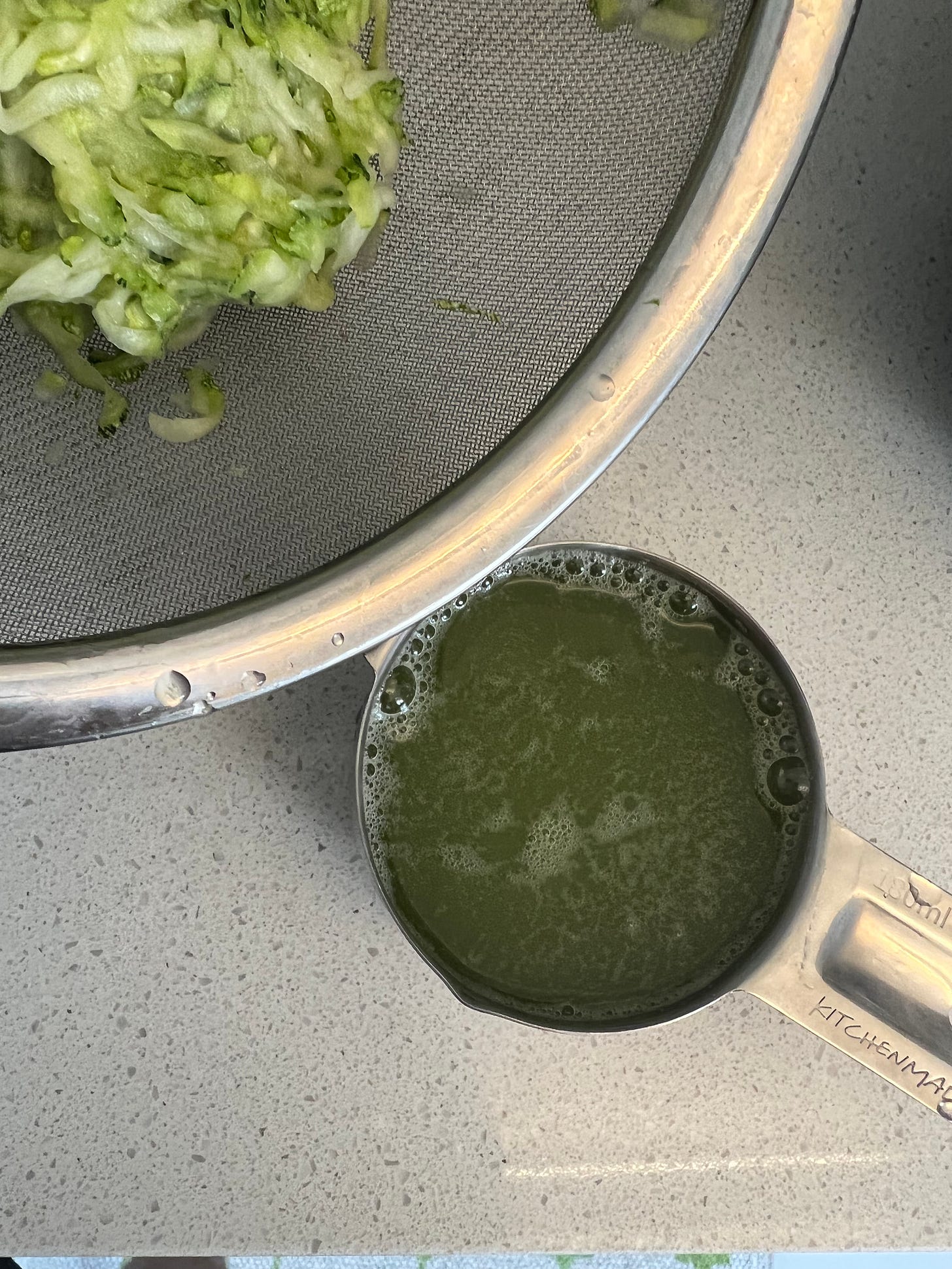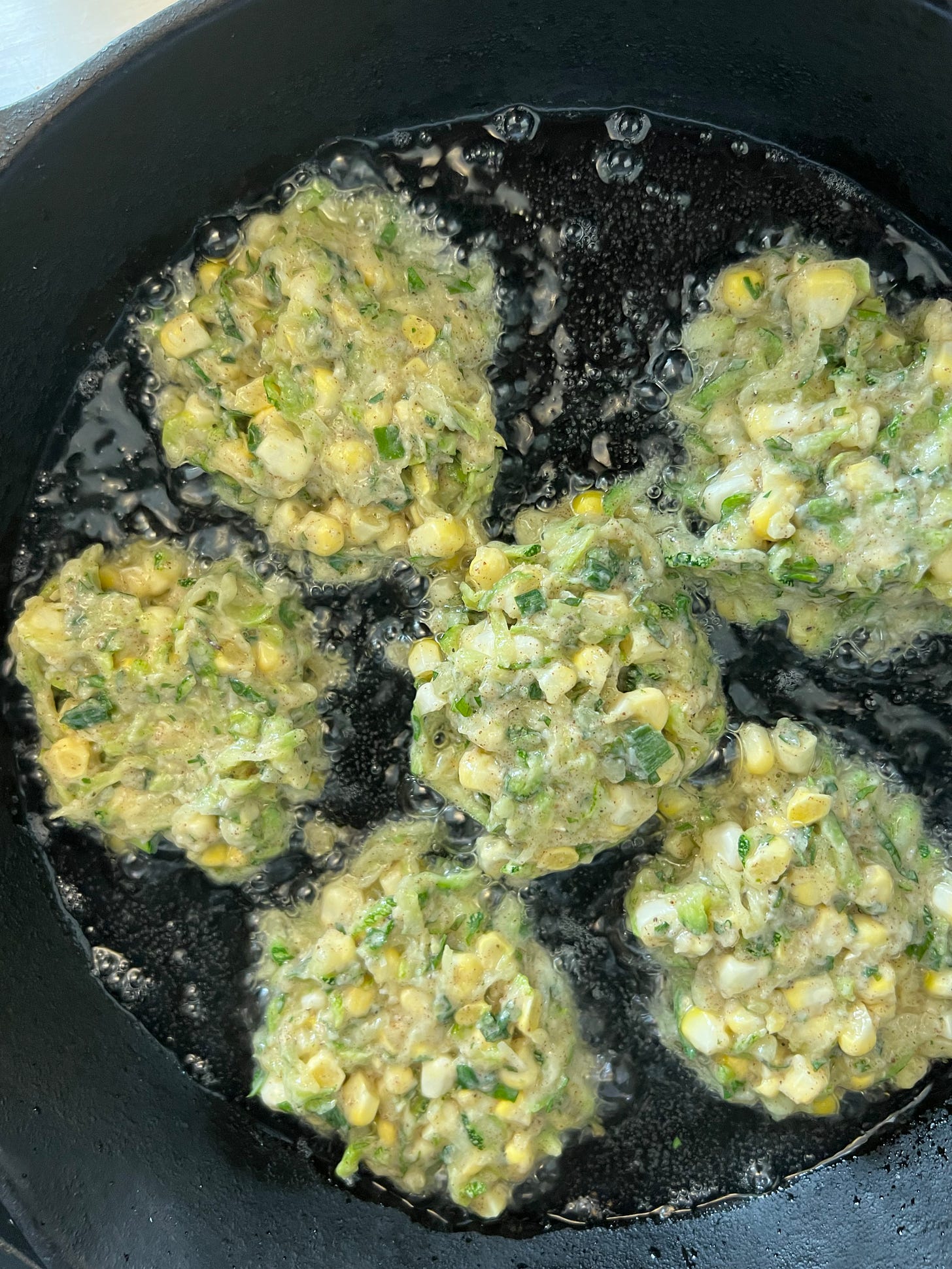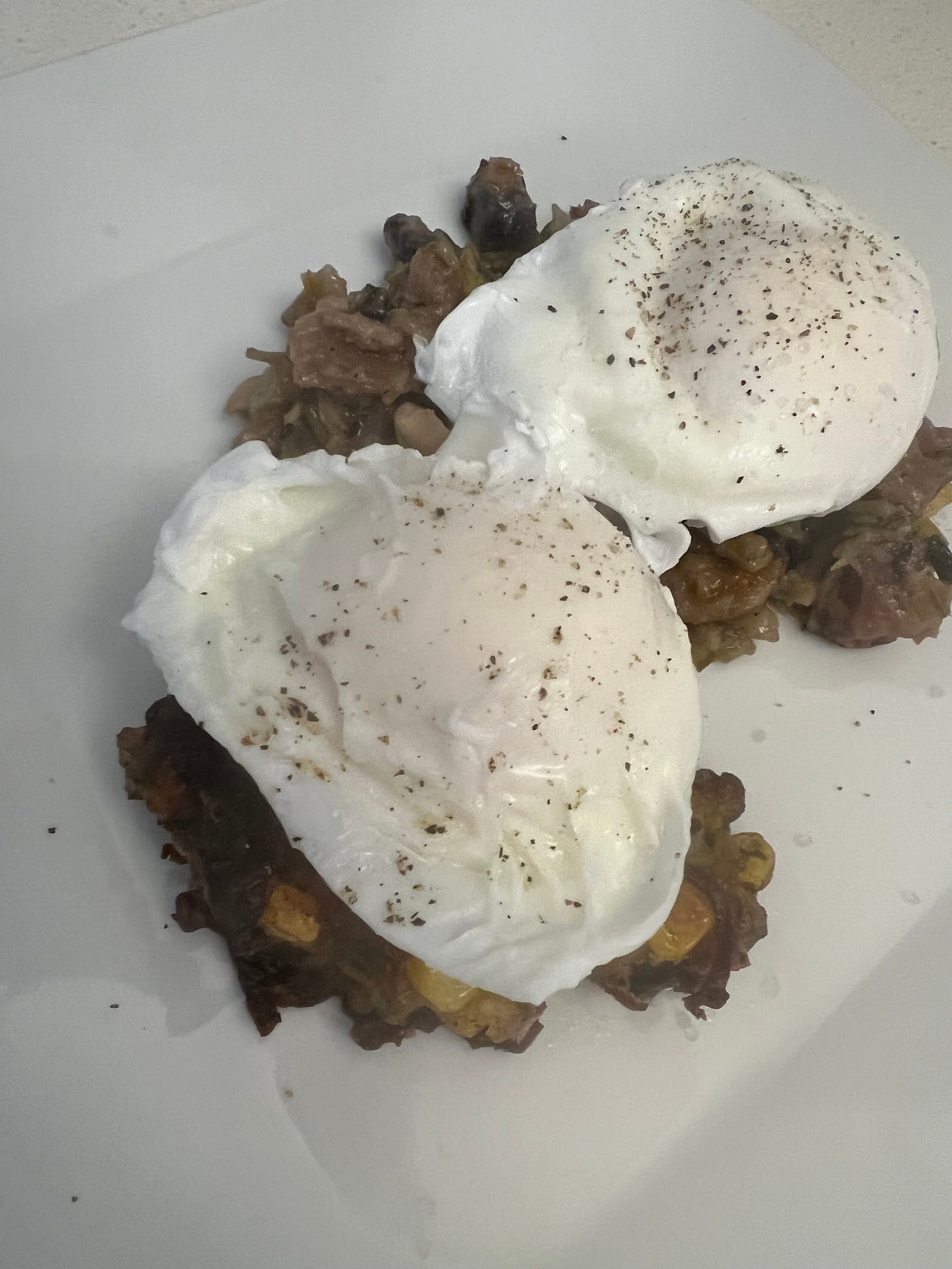We’ve been eating so many more plants and so much less meat during these hot summer days, when the gardens and markets are flush, it’s fitting that my guest on What’s Burning this week is Matthew Kenney, chef, owner, and inspiration behind more than fifty vegan restaurants around the world. You can tune in to our fascinating conversation about the gastronomic opportunities and challenges presented by vegan cooking here. Now, onto today’s plant-forward recipe, vegetable fritters. Thank you for your continued support. —Mitchell
Last week it was zucchini blossoms. This week it is zucchini. No matter how many blossoms we eat, we still can’t seem to stem the flow of giant zucchini from the garden. Luckily, one way both Nate and I love to eat zucchini is in fritters, proving, yet again, that anything fried is delicious.

Fritters are more or less pancakes, a sacred culinary category in our home. I prefer my fritters thick and crisp, rather than thin and soggy. To get them this way, zucchini poses a bit of a challenge, especially in its ginormous form, because it is so full of water. That’s why I shred, salt, drain, and squeeze the zucchini within an inch of its life to remove as much liquid (and pent up aggression) as possible. You can use other vegetables, too, of course. If they are watery, such as cabbage or kohlrabi, you should shred, salt, and squeeze them, too. Keep the different vegetables separate during the process, combining them only once they’ve been squoze. Cooked spinach, chard, kale, beet or turnip tops are another good addition, but they also need to be squeezed really well and chopped before adding.
Another secret is not to rely on all-purpose flour to do all your bidding, I mean, binding. Sure, it works, but I find fritters need more heft to hold all the vegetables together and keep moisture at bay. I use a combination of flour, chickpea flour or besan (an Indian fritter staple) and starch (corn, potato, or rice), the last something I learned from my Korean pancake explorations. This combination of binders gives me the density and crispness I want in my fritters. You can substitute whatever other legume flour you’ve got or prefer for the chickpea flour. Even breadcrumbs work well. One of the culinary benefits of the spread of gluten intolerance is a preponderance of different flours in the grocery store. I can easily count 10 in my cupboard off the top of my head and I know I have more. Experiment with what you’ve got.
Another hack I’m using these days to add flavor and crispness to my fritters is cheese. (I confess I saw it somewhere on Instagram.) I don’t mean a smidgen of Parmigiano, I mean a decent amount of hard, aged, grated cheese, such as Gruyère, Comté or similar. You can still add a smidgen of Parmigiano, too, while you’re at it.
Finally, let’s talk about aromatics and herbs. I used to use a sprig of this, a tablespoon of that. But ever since I’ve been spending more time in Israel and cooking more Israel inspired food, I use herbs by the cupful and bunch. Call it “the Ottolenghi effect,” though herbs are pervasive in Israeli and throughout Middle Eastern cooking. Using copious amounts of herbs not only adds tremendous flavor to your food, but it also prevents waste. How many necrotic bunches of herbs end up in the compost? You’ll see in this recipe I give a range of ¼ cup to ¾ cup of chopped herbs, according to your taste preferences.
You needn’t stop at aromatics and herbs. So many other flavors are delightful in fritters, such as preserved lemon, toasted cumin, smoked paprika, or roasted garlic. Once you master the basic formula, feel free to experiment.
To serve, I like to offer a condiment or two with my fritters. Perhaps an extension of my love for the latke-and-sour-cream duet, labne is a favorite fritter accompaniment of mine (see Issue #4). So is any hummus, tzatziki, or salsa. The other day we had dinner at the home of a colleague of Nate’s and she had made a remarkable date chutney from a Samin Nosrat recipe. It was delicious. I quickly located the recipe on the New York Times website and made a half batch (with a quarter of the jalapéno). It is particularly good on these fritters.
RECIPE: Summer Fritters
(Makes about a dozen or more fritters)
1 pound zucchini, shredded (about 2 ¼ cups, tightly packed)
Salt
Kernels from 1 large ear of corn (about 1 cup), or another vegetable (see note, below)
1/4 to 3/4 cup chopped aromatics and herbs, such as scallions, basil, mint, parsley, thyme, cilantro, or a combination
1/3 cup or more shredded cheese, such as Gruyère, Comté, cheddar, or any hard, aged cheese
2 tablespoons all-purpose flour
2 tablespoons chickpea flour (or besan), or other legume flour, or bread crumbs, matzo meal, or additional flour
1 tablespoon corn or potato starch, or rice flour
1 egg
Fresh ground black pepper
Peanut or other neutral oil for frying
Place the shredded zucchini in a large mesh sieve set over a medium bowl. Sprinkle about a teaspoon of salt over the zucchini and mix it into the shreds. Let stand for about 30 minutes, after which you’ll find a pool of liquid in the bottom of the bowl. While still in the sieve, squeeze the zucchini in your hands to extract as much liquid as possible. Don’t hold back. Get our all your frustrations and all the zucchini juice out. I get about ¾ of a cup juice and end up with a little more than 1 cup of densely packed, shredded, squeezed zucchini. Dump out the liquid and place the zucchini in the bowl.

Add the corn to the zucchini, along with the chopped herbs, shredded cheese, all-purpose flour, chickpea flour, starch, egg, and a generous amount of black pepper. Mix well. The mixture should be thick and chock full of vegetables. Line a plate or tray with paper towel.
Using a cast-iron skillet, heat just enough peanut oil to coat the bottom of the pan by a scant 1/8 inch. Once hot, spoon generous tablespoonfuls of the mixture into the hot oil and flatten a little to make pancakes. Don’t make them too thin. Aim for a 1/2 inch or so. Let the first side fry until nicely brown, about 5 minutes. Note, when frying fresh corn kernels, beware. They have a tendency to pop and send searing hot droplets of oil onto any exposed skin. If you have a splatter guard, use that. Cover up your arms and stand back from the pan, even when you are flipping.
When that first side is nicely browned, flip to brown the second side, another 4 or 5 minutes. Remove to drain on the prepared plate and repeat with the remaining fritter mixture. Serve with labne, salsa, or any condiment you enjoy.
Note: If you are using another watery vegetable instead of corn, or zucchini, for that matter, such as shredded cabbage or kohlrabi, repeat the procedure of salting, draining, and squeezing, keeping the two vegetables separate. You’ll need about 2 cups of a vegetable to produce 1 cup salted and squeezed. Once squeezed, add the second vegetable to the first and proceed with the recipe as directed. Cooked spinach, chard, beet or turnip tops are another good addition, but after cooking they also need to be squeezed really well and chopped before adding.
Another Note: Got leftover fritters? Reheat them for 20 seconds in the microwave and stick ‘em in pita or another type of sandwich. Even better, poach an egg (Issue #12) and serve it on top of a fritter for breakfast. Or, who are we kidding, just eat them cold out of the fridge. I did all three this week.








I don't dare fritter away the afternoon, but what else can one do when Inbox includes both Kitchen Sense and Bonnie's Aug2022 Food News? "Dano's restaurant, now run by his wife Karen, is where my best friends Mitchell Davis and Nate Goldstein got married so it is hard for me to judge. But it really is great in every way. We loved the dips and spreads, and the schnitzel was truly amazing. Don't miss Karen's exceptional desserts."
If that's not enough to render me speechless or wordless (equally difficult to do), the showstopper is The Baby Gift. Someone with SM savvy has to make car-seated Francois go viral. Grinning 'n frittering - M
Delicious and surprisingly simple to make. I used vegan cheese because that was all I had. Thank you